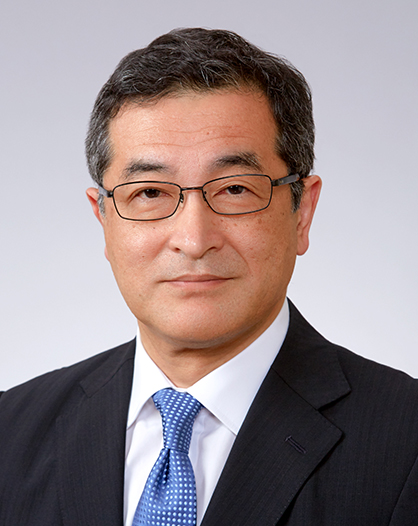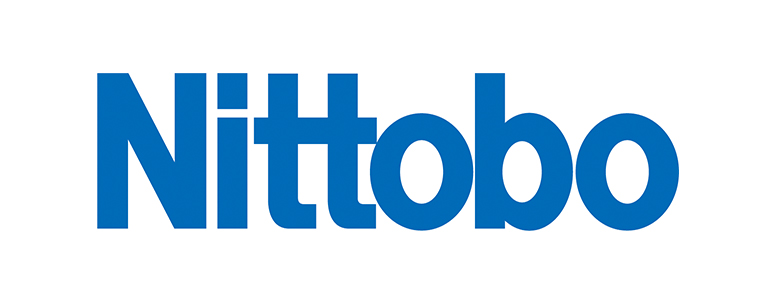| NITTO BOSEKI CO., LTD. (3110) |
|
||||||||
Company |
NITTO BOSEKI CO., LTD. |
||
Code No. |
3110 |
||
Exchange |
TSE 1st Section |
||
Industry |
Glass and ceramics products (manufacturing) |
||
Representative and Chief Executive Officer |
Yuichi Tsuji |
||
Address |
Kojimachi-odori Bldg., 2-4-1, Kojimachi, Chiyoda-ku, Tokyo |
||
Year-end |
End of March |
||
URL |
|||
*The share price is the closing price on Nov. 29. The number of shares issued is as of the end of Sep. 2018.
ROE and BPS are actual results in the term ended Mar. 2018. EPS is the company's estimate. |
||||||||||||||||||||||||
|
|
*The estimates are from the company. A 1-for-5 reverse stock split was conducted on Oct. 1, 2017. EPS and DPS were adjusted retroactively.
|
|
| Key Points |
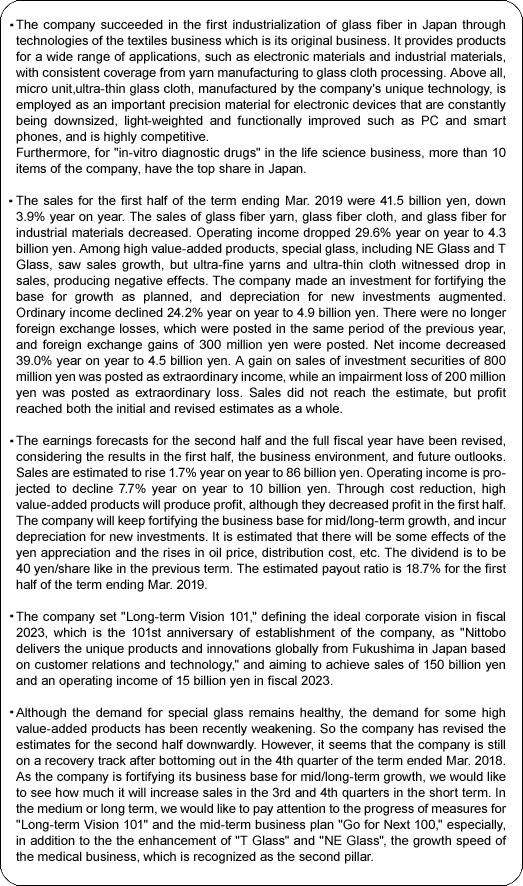 |
| Company Overview |
|
The company succeeded in the first industrialization of glass fiber in Japan through technologies of the textiles business which is its original business. It provides products for a wide range of applications, such as electronic materials and industrial materials, with consistent coverage from yarn manufacturing to glass cloth processing.
Above all, micro-unit, ultra-thin glass cloth, manufactured by the company's unique technology, is employed as an important precision material for electronic devices that are constantly being downsized, light-weighted and functionally improved such as PC and smart phones, and is highly competitive.
Furthermore, for "in-vitro diagnostic drugs" in the life science business, more than 10 items of the company, have the top share in Japan.
【1-1 Corporate History】
"Koriyama Kenshi Boseki Co., Ltd" founded in Koriyama, Fukushima Prefecture in 1898, is the predecessor. The company has a history of 120 years.
Nitto Boseki Co., Ltd. was established in 1923 when Fukushima Boshoku Co., Ltd. (formerly Fukushima Seiren Seishi Co., Ltd.) acquired the ownership of the Iwashiro Spinning Plant of Katakura Seishi (former Koriyama Kenshi Boseki Co.,Ltd) in 1918.
In 1938, it succeeded in industrialization (mass production) of glass fiber for the first time in Japan. In the world, Owens Corning Glass Fiber of the United States has achieved the industrialization of glass fiber around the same time.
In 1949, it began manufacturing glass wool for the first time in Japan.
In 1969, utilizing the technologies cultivated in the textile business, the company began manufacturing glass cloth for printed circuit board. In 1982, it began manufacturing test reagents for blood coagulation factors. And in 1983, it succeeded in industrializing functional polymers "PAA®" for the first time in the world. As such, the company has continued to challenge new fields and expanded its business fields.
It has established the "Long-term Vision 101" and medium-term management plan, "Go for Next 100" targeting its 100th anniversary in April 2023 and is currently implementing them.
【1-2 Corporate Philosophy】
Its corporate philosophy is as follows: "As a corporate citizen contributing to healthy and comfortable lifestyles, the Nittobo Group endeavors to raise its value within society through consistent effort to realize a more affluent society for everyone."
Furthermore, under the following Nittobo Declaration, it is aiming to be society's "best partner" in collaboration with all stakeholders.
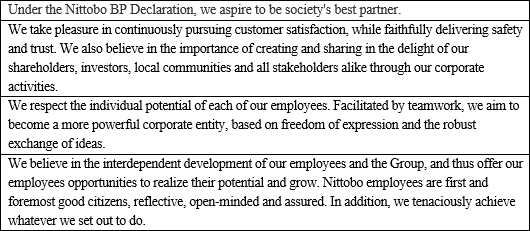 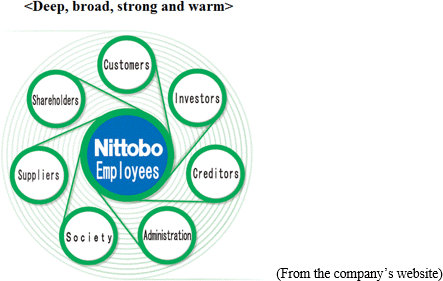 【1-3 Business contents】
(1) Business contents
The company's business can be largely divided into three categories, namely, the "Textiles Business" which manufactures and sells textile products mainly for the apparel industry, the "Glass Fiber Business" which manufactures and sells various products using glass fiber, and the "Life Science Business" that manufactures in-vitro diagnostics in the immunology field and specialty chemicals products.
As for the reporting segments, the "Glass Fiber Business" is divided into three categories, namely, the "Glass Fiber Yarn Business," "Glass Fiber Cloth Business," and "Glass Fiber for Industrial Materials Business." Together with the "Textiles Business" and "Life Science Business," there are a total of 5 reporting segments. In addition, there is a category called "Others" which consists of the real estate business and service business that are not included in the reporting segment. 【1-3 Business contents】
(1) Business contents
The company's business can be largely divided into three categories, namely, the "Textiles Business" which manufactures and sells textile products mainly for the apparel industry, the "Glass Fiber Business" which manufactures and sells various products using glass fiber, and the "Life Science Business" that manufactures in-vitro diagnostics in the immunology field and specialty chemicals products.
As for the reporting segments, the "Glass Fiber Business" is divided into three categories, namely, the "Glass Fiber Yarn Business," "Glass Fiber Cloth Business," and "Glass Fiber for Industrial Materials Business." Together with the "Textiles Business" and "Life Science Business," there are a total of 5 reporting segments. In addition, there is a category called "Others" which consists of the real estate business and service business that are not included in the reporting segment.
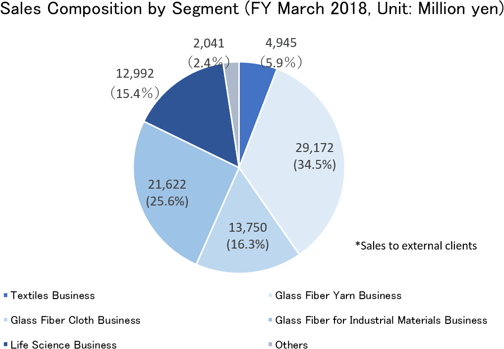 (1) Textiles Business
The company provides products utilizing its unique technologies to respond to the diversifying needs of customers, from yarns that are indispensable for clothing, to secondary materials and products. "C・S・Y (Core Spun Yarn)" is the double-structured texitle which is the precursor of stretch fabrics. "Dan Reine" is adhesive interlining for women and has been boasting high market share. And "Nittobo Dishcloth" won the 2015 Good Design Long Life Design Award.
The company is planning to pursue integrated management of its overseas bases such as Nittobo (China) Co., Ltd. with domestic businesses, strengthen its development capabilities, and strive to produce higher value-added products and enhance customer appeal. (1) Textiles Business
The company provides products utilizing its unique technologies to respond to the diversifying needs of customers, from yarns that are indispensable for clothing, to secondary materials and products. "C・S・Y (Core Spun Yarn)" is the double-structured texitle which is the precursor of stretch fabrics. "Dan Reine" is adhesive interlining for women and has been boasting high market share. And "Nittobo Dishcloth" won the 2015 Good Design Long Life Design Award.
The company is planning to pursue integrated management of its overseas bases such as Nittobo (China) Co., Ltd. with domestic businesses, strengthen its development capabilities, and strive to produce higher value-added products and enhance customer appeal.
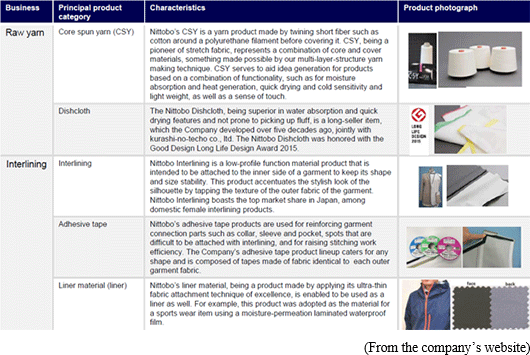 (2) Glass Fiber Business
The company succeeded in the first industrialization of glass fiber in Japan. It provides products for a wide range of applications with consistent coverage from yarn manufacturing to glass cloth processing.
Above all, micro-unit, ultra-thin glass cloth is employed as an important precision material for electronic devices that are constantly being downsized, light-weighted and functionally improved such as PC and smart phones, and its quality receiving high appraisal throughout the world.
In addition, the company spearheaded the manufacturing of glass wool in Japan to be used as insulation for housing, and is regarded as the pioneer of heat insulation materials with its unique technologies. In particular, high performance glass wool contributes to an energy-saving society as heat insulation materials for very airtight and highly heated insulating houses. (2) Glass Fiber Business
The company succeeded in the first industrialization of glass fiber in Japan. It provides products for a wide range of applications with consistent coverage from yarn manufacturing to glass cloth processing.
Above all, micro-unit, ultra-thin glass cloth is employed as an important precision material for electronic devices that are constantly being downsized, light-weighted and functionally improved such as PC and smart phones, and its quality receiving high appraisal throughout the world.
In addition, the company spearheaded the manufacturing of glass wool in Japan to be used as insulation for housing, and is regarded as the pioneer of heat insulation materials with its unique technologies. In particular, high performance glass wool contributes to an energy-saving society as heat insulation materials for very airtight and highly heated insulating houses.
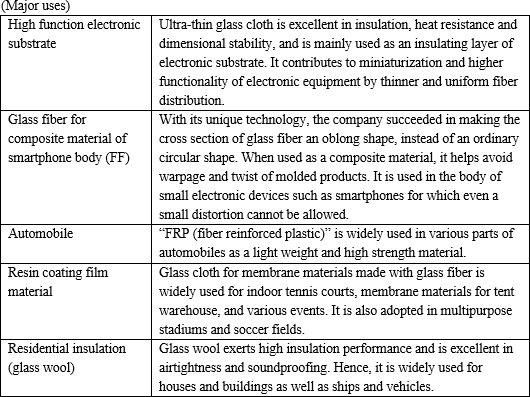 <What is glass fiber?>
Glass fiber is a product for which glass is melted at a high temperature of 1,300℃ or higher and stretched to be fibrous.
The company succeeded in the industrialization of glass fiber for the first time in 1938 in Japan, and it developed rapidly thereafter.
Its characteristics include strength, heat resistance, non-flammability, electrical insulation and chemical resistance, and it is used for various purposes such as building materials, and printed circuit boards. For its excellent characteristics, it is being used in a wide range of industries.
(Composition, property)
As described earlier, it has characteristics such as strength, heat resistance, non-flammability, and electrical insulation. However, to be applied as electronic materials, higher level of performance including high strength, high elasticity, and low dielectric is required.
(Manufacturing method)
After raw materials of glass are melted at a high temperature of 1,300 to 1,600℃, they pass through a dedicated machine called a platinum nozzle and are reeled up to form a filament. A very precise control technique is required.
The thinness of the glass fiber, which is a glass base pulled out from the machine at high speed, is 4 to 24 micrometers in diameter. (*The thinness of a human hair is about 50 to 100 micrometers.)
The spun glass fiber is processed into product forms according to the application.
(Major product forms)
◎Yarns
Yarns (spun fiber) include a single yarn which is a strand composed of several hundred filaments that are simultaneously spun and twisted in the same direction and a twisted yarn which is made by twisting several single yarns.
The "E glass yarn," a single yarn made of twisted strands mainly composed of filaments of 4.0 μm to 7.4 μm, is generally used formaking glass cloth. As an industrial material, it is highly evaluated as a substrate for composite materials that have the high degree of compatibility with resin and excellent workability by the company's unique surface treatment technology.
◎Glass cloth
Glass cloth, which is fabric (cloth form) made of glass fiber yarns, is used for a wide range of applications such as printed circuit boards, damping materials, tent films, and road reinforcement materials.
Among them, the glass cloth used for printed circuit boards and electronic parts is the company's flagship product that it boasts worldwide.
【Glass cloth for printed circuit boards】
A printed circuit board is formed of the fine wiring of metals such as copper on the surface of a base body such as resin, and components including resistors, capacitors and IC chips are fixed by soldering on the wiring. It is an important parts that influence the performance of all electronic equipment, including PC, smartphones, servers, medical equipment, industrial robots, automobiles, and aircraft.
<What is glass fiber?>
Glass fiber is a product for which glass is melted at a high temperature of 1,300℃ or higher and stretched to be fibrous.
The company succeeded in the industrialization of glass fiber for the first time in 1938 in Japan, and it developed rapidly thereafter.
Its characteristics include strength, heat resistance, non-flammability, electrical insulation and chemical resistance, and it is used for various purposes such as building materials, and printed circuit boards. For its excellent characteristics, it is being used in a wide range of industries.
(Composition, property)
As described earlier, it has characteristics such as strength, heat resistance, non-flammability, and electrical insulation. However, to be applied as electronic materials, higher level of performance including high strength, high elasticity, and low dielectric is required.
(Manufacturing method)
After raw materials of glass are melted at a high temperature of 1,300 to 1,600℃, they pass through a dedicated machine called a platinum nozzle and are reeled up to form a filament. A very precise control technique is required.
The thinness of the glass fiber, which is a glass base pulled out from the machine at high speed, is 4 to 24 micrometers in diameter. (*The thinness of a human hair is about 50 to 100 micrometers.)
The spun glass fiber is processed into product forms according to the application.
(Major product forms)
◎Yarns
Yarns (spun fiber) include a single yarn which is a strand composed of several hundred filaments that are simultaneously spun and twisted in the same direction and a twisted yarn which is made by twisting several single yarns.
The "E glass yarn," a single yarn made of twisted strands mainly composed of filaments of 4.0 μm to 7.4 μm, is generally used formaking glass cloth. As an industrial material, it is highly evaluated as a substrate for composite materials that have the high degree of compatibility with resin and excellent workability by the company's unique surface treatment technology.
◎Glass cloth
Glass cloth, which is fabric (cloth form) made of glass fiber yarns, is used for a wide range of applications such as printed circuit boards, damping materials, tent films, and road reinforcement materials.
Among them, the glass cloth used for printed circuit boards and electronic parts is the company's flagship product that it boasts worldwide.
【Glass cloth for printed circuit boards】
A printed circuit board is formed of the fine wiring of metals such as copper on the surface of a base body such as resin, and components including resistors, capacitors and IC chips are fixed by soldering on the wiring. It is an important parts that influence the performance of all electronic equipment, including PC, smartphones, servers, medical equipment, industrial robots, automobiles, and aircraft.
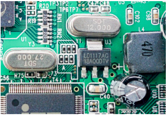 For the insulator of the board body, various materials such as glass and polyester resin are used. Glass fiber, which has characteristics of high insulation, high strength, heat resistance, and dimensional stability, is thought to be the most suitable material for a printed circuit board.
Along with remarkable development of digital technologies, electronic devices such as PC and smartphones are becoming lighter, thinner, smaller and more sophisticated, and the need for the improvement of glass cloth performance is increasing.
In response to these needs, the company develops high function glass cloth products such as "Low dielectric glass cloth (NE-glass)," "Low CTE glass cloth (T-glass)," and "Ultra-thin glass cloth," using the strengths of integrated manufacturing based on its unique technologies including glass composition development technology, fiber development technology and textile processing technology and has a high market share.
"Low dielectric glass cloth (NE-glass)"
Higher speed transmission with higher frequency is becoming more common, and low dielectric materials that reduce transmission loss is needed for printed circuit boards.
To address the need, the company has developed the "NE-glass" that is excellent in low dielectric constant and dissipation factor with the same characteristics as "E-glass" by lowering the component ratio of alkaline-earth elements (CaO, MgO) as compared with the conventional "E-glass" while enhancing the component ratio of boric acid (B2O3).
It is mainly used for electronic boards for data centers and base station servers.
"Low CTE glass cloth (T-glass)"
"T glass" has the higher component ratio of silica (SiO2) and alumina (Al2O3) compared with the standard "E-glass" and provides significantly advanced mechanical and thermal performance of glass fiber.
Utilizing its low thermal expansion characteristics and high tensile elasticity, it realizes excellent dimensional stability and increased rigidity, and it is used as an electronic substrate for semiconductor packages mainly mounted on smartphones as a high performance electronic material.
Like carbon fiber and aramid fiber, it also works well as a reinforcing material for advanced composite materials, so it is used by itself or as a hybrid material with carbon fiber in the fields of aviation, space and sports.
"Ultra-thin glass cloth"
Demand for thinner glass cloth is increasing as a material to respond to the trend of making lighter, thinner and smaller printed circuit boards with high density packaging. In addition to its thinness, the company's ultra-thin glass cloth has superb capacities to process fine holes both for laser and drill processing and offers great dimensional stability and surface smoothness as a laminated plate.
The product forms and uses by segment in the glass fiber business are as follows.
For the insulator of the board body, various materials such as glass and polyester resin are used. Glass fiber, which has characteristics of high insulation, high strength, heat resistance, and dimensional stability, is thought to be the most suitable material for a printed circuit board.
Along with remarkable development of digital technologies, electronic devices such as PC and smartphones are becoming lighter, thinner, smaller and more sophisticated, and the need for the improvement of glass cloth performance is increasing.
In response to these needs, the company develops high function glass cloth products such as "Low dielectric glass cloth (NE-glass)," "Low CTE glass cloth (T-glass)," and "Ultra-thin glass cloth," using the strengths of integrated manufacturing based on its unique technologies including glass composition development technology, fiber development technology and textile processing technology and has a high market share.
"Low dielectric glass cloth (NE-glass)"
Higher speed transmission with higher frequency is becoming more common, and low dielectric materials that reduce transmission loss is needed for printed circuit boards.
To address the need, the company has developed the "NE-glass" that is excellent in low dielectric constant and dissipation factor with the same characteristics as "E-glass" by lowering the component ratio of alkaline-earth elements (CaO, MgO) as compared with the conventional "E-glass" while enhancing the component ratio of boric acid (B2O3).
It is mainly used for electronic boards for data centers and base station servers.
"Low CTE glass cloth (T-glass)"
"T glass" has the higher component ratio of silica (SiO2) and alumina (Al2O3) compared with the standard "E-glass" and provides significantly advanced mechanical and thermal performance of glass fiber.
Utilizing its low thermal expansion characteristics and high tensile elasticity, it realizes excellent dimensional stability and increased rigidity, and it is used as an electronic substrate for semiconductor packages mainly mounted on smartphones as a high performance electronic material.
Like carbon fiber and aramid fiber, it also works well as a reinforcing material for advanced composite materials, so it is used by itself or as a hybrid material with carbon fiber in the fields of aviation, space and sports.
"Ultra-thin glass cloth"
Demand for thinner glass cloth is increasing as a material to respond to the trend of making lighter, thinner and smaller printed circuit boards with high density packaging. In addition to its thinness, the company's ultra-thin glass cloth has superb capacities to process fine holes both for laser and drill processing and offers great dimensional stability and surface smoothness as a laminated plate.
The product forms and uses by segment in the glass fiber business are as follows.
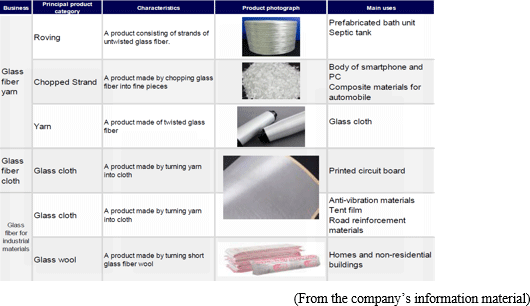 (3) Life Science Business
The Life Science Business consists of the Medical Division and the Environment and Health Division.
The Medical Division manufactures and sells in-vitro diagnostic drugs used for blood and urine tests and specialty chemicals products centered on functional polymers.
The company is achieving high quality and stable supply of the "in-vitro diagnostic drugs" that are used in health checkups and thorough physical examinations to examine health status using blood or urine, by integrally manufacturing them from the antiserum as the raw material to the diagnostic drugs as the final product within the Group.
The products' high quality has been recognized, and they are supplied in medical fields globally. In Japan, the company is winning the top share with more than 10 items.
As for the Specialty Chemicals Business, the company develops and sells unique functional polymers (polyallylamine and polyamine series). The characteristics of this business are R&D together with chemical products/pharmaceutical manufacturers and research institutes and product proposals that capture customer needs. The company is strong in niche markets and is actively expanding the business not only in Japan but also in the global market.
For the Environment and Health Business, the company utilizes the technologies that have been cultivated over many years to develop a business in the beverage industry.
In the beverage business, centered on the private brands, it is working on development of plastic bottles, beverage production and bottling. (3) Life Science Business
The Life Science Business consists of the Medical Division and the Environment and Health Division.
The Medical Division manufactures and sells in-vitro diagnostic drugs used for blood and urine tests and specialty chemicals products centered on functional polymers.
The company is achieving high quality and stable supply of the "in-vitro diagnostic drugs" that are used in health checkups and thorough physical examinations to examine health status using blood or urine, by integrally manufacturing them from the antiserum as the raw material to the diagnostic drugs as the final product within the Group.
The products' high quality has been recognized, and they are supplied in medical fields globally. In Japan, the company is winning the top share with more than 10 items.
As for the Specialty Chemicals Business, the company develops and sells unique functional polymers (polyallylamine and polyamine series). The characteristics of this business are R&D together with chemical products/pharmaceutical manufacturers and research institutes and product proposals that capture customer needs. The company is strong in niche markets and is actively expanding the business not only in Japan but also in the global market.
For the Environment and Health Business, the company utilizes the technologies that have been cultivated over many years to develop a business in the beverage industry.
In the beverage business, centered on the private brands, it is working on development of plastic bottles, beverage production and bottling.
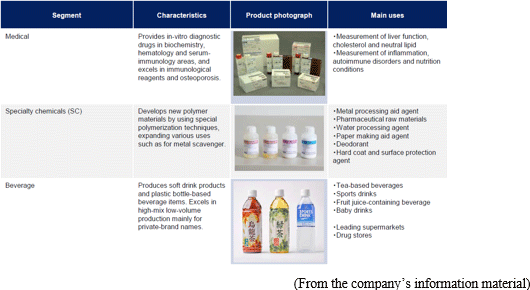 (2) Research and development (R&D)
Since its founding, the Group has been actively promoting R&D and delivering products unique to the Group to the world.
R&D will continue to be a source of enhancing the company's competitiveness and corporate value.
In recent years, while the needs of customers are becoming more sophisticated and diversified, global competition is intensifying. Under these circumstances, the company established its general research laboratory in 2017 to provide products and services with high added-value and strong originality in a timely manner with its characteristics and strengths, and to promote R&D and technology development with an eye toward the future.
The Group will continuously work on R&D and technology development from the viewpoint of expertise in each business division. At the same time, it will promote cross-sectional management by the research laboratory to pursue synergy among businesses with a focus on speed.
Furthermore, in each field, in order to accelerate research speed and expand the perspectives, the company is actively promoting joint research on industry, government and academia from the viewpoint of open innovation.
【1-4 Characteristics and strengths】
◎ Supply products by accurately grasping needs of the times
In addition to succeeding in the industrialization of glass fiber for the first time in Japan, the company began manufacturing glass wool for the first time in Japan. As such, the company has been always leading the global and Japanese markets in the field of glass fiber. In the history of over ninety years, it has always been capturing the changes and needs of the world accurately and developing and supplying various products centered on glass fiber.
Since the company is not manufacturing final products, people do not see the company's products. However, it supplies materials that are indispensable to the world and supports our lives behind the scenes.
◎ High competitiveness by unique technologies
Among many manufacturers of glass fiber in the world, it is almost the only company that realized excellent low dielectric constant and low dielectric loss tangent (NE-glass) and high dimensional stability and higher rigidity (T-glass) in the field of glass cloth for electronic materials and has established a system that can stably supply sufficient volume.
In addition, having acquired the top share in Japan for more than 10 items with in-vitro diagnostic drugs in the Medical Division also shows its high competitiveness with its unique technologies.
【1-5 ROE Analysis】 (2) Research and development (R&D)
Since its founding, the Group has been actively promoting R&D and delivering products unique to the Group to the world.
R&D will continue to be a source of enhancing the company's competitiveness and corporate value.
In recent years, while the needs of customers are becoming more sophisticated and diversified, global competition is intensifying. Under these circumstances, the company established its general research laboratory in 2017 to provide products and services with high added-value and strong originality in a timely manner with its characteristics and strengths, and to promote R&D and technology development with an eye toward the future.
The Group will continuously work on R&D and technology development from the viewpoint of expertise in each business division. At the same time, it will promote cross-sectional management by the research laboratory to pursue synergy among businesses with a focus on speed.
Furthermore, in each field, in order to accelerate research speed and expand the perspectives, the company is actively promoting joint research on industry, government and academia from the viewpoint of open innovation.
【1-4 Characteristics and strengths】
◎ Supply products by accurately grasping needs of the times
In addition to succeeding in the industrialization of glass fiber for the first time in Japan, the company began manufacturing glass wool for the first time in Japan. As such, the company has been always leading the global and Japanese markets in the field of glass fiber. In the history of over ninety years, it has always been capturing the changes and needs of the world accurately and developing and supplying various products centered on glass fiber.
Since the company is not manufacturing final products, people do not see the company's products. However, it supplies materials that are indispensable to the world and supports our lives behind the scenes.
◎ High competitiveness by unique technologies
Among many manufacturers of glass fiber in the world, it is almost the only company that realized excellent low dielectric constant and low dielectric loss tangent (NE-glass) and high dimensional stability and higher rigidity (T-glass) in the field of glass cloth for electronic materials and has established a system that can stably supply sufficient volume.
In addition, having acquired the top share in Japan for more than 10 items with in-vitro diagnostic drugs in the Medical Division also shows its high competitiveness with its unique technologies.
【1-5 ROE Analysis】
 The company's goal is to achieve 8% or more in the fiscal year ending March 2020 and 10% or more in the fiscal year ending 2023.
The ROE for the fiscal year ended March 2018 greatly increased, as the company posted a gain of 4.2 billion yen on the sale of non-current assets in net income.
Expansion of sales of high value-added products and promotion of cost reduction will be the keys.
The company's goal is to achieve 8% or more in the fiscal year ending March 2020 and 10% or more in the fiscal year ending 2023.
The ROE for the fiscal year ended March 2018 greatly increased, as the company posted a gain of 4.2 billion yen on the sale of non-current assets in net income.
Expansion of sales of high value-added products and promotion of cost reduction will be the keys.
|
| Earnings Trends |
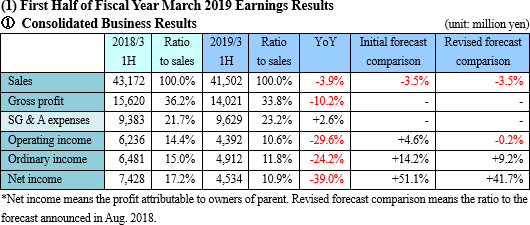 Sales declined slightly, and profit dropped, but exceeded the estimate.
Sales were 41.5 billion yen, down 3.9% year on year. The sales of glass fiber yarn, glass fiber cloth, and glass fiber for industrial materials decreased.
Operating income dropped 29.6% year on year to 4.3 billion yen. Among high value-added products, special glass saw sales growth, but ultra-fine yarns and ultra-thin cloth witnessed drop in sales, producing negative effects. The company made an investment for fortifying the base for growth as planned, and depreciation for new investments augmented.
Ordinary income declined 24.2% year on year to 4.9 billion yen. There were no longer foreign exchange losses, which were posted in the same period of the previous year, and foreign exchange gains of 300 million yen were posted.
Net income decreased 39.0% year on year to 4.5 billion yen. A gain on sales of investment securities of 800 million yen was posted as extraordinary income, while an impairment loss of 200 million yen was posted as extraordinary loss.
Sales did not reach the estimate, but profit as a whole reached the upwardly-revised forecast. Sales declined slightly, and profit dropped, but exceeded the estimate.
Sales were 41.5 billion yen, down 3.9% year on year. The sales of glass fiber yarn, glass fiber cloth, and glass fiber for industrial materials decreased.
Operating income dropped 29.6% year on year to 4.3 billion yen. Among high value-added products, special glass saw sales growth, but ultra-fine yarns and ultra-thin cloth witnessed drop in sales, producing negative effects. The company made an investment for fortifying the base for growth as planned, and depreciation for new investments augmented.
Ordinary income declined 24.2% year on year to 4.9 billion yen. There were no longer foreign exchange losses, which were posted in the same period of the previous year, and foreign exchange gains of 300 million yen were posted.
Net income decreased 39.0% year on year to 4.5 billion yen. A gain on sales of investment securities of 800 million yen was posted as extraordinary income, while an impairment loss of 200 million yen was posted as extraordinary loss.
Sales did not reach the estimate, but profit as a whole reached the upwardly-revised forecast.
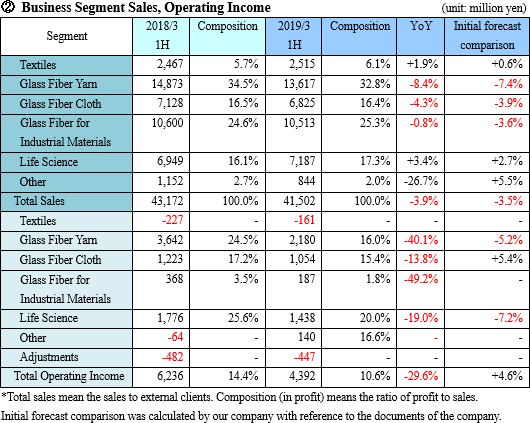 ① Textiles Business
Sales grew, and loss shrank.
Interlining cloth, which is the core product of the business segment, sold well in Japan and China, especially for ladies’ clothes.
② Glass Fiber Yarn Business
Sales and profit declined.
As the production of smartphones was adjusted, the sales of FFand glass yarns for electronic materials, especially high value-added products, decreased. In addition, revenue worsened due to the revamping of large-scale equipment in the first quarter.
③ Glass Fiber Cloth Business
Sales and profit dropped.
The demand for products used as electronic materials was healthy. The company strived to improve the productivity of high value-added products, but it was affected by the typhoon damage to Nittobo Macau Glass Weaving Co., Ltd.
④ Glass Fiber for Industrial Materials Business
Sales and profit shrank.
The sales of glass cloth for equipment and construction materials were stable. The revenue from heat-insulation materials for housing worsened, due to the sluggish market and the augmentation of cost for revamping large-scale equipment in the first quarter, expenses for distribution, materials, fuel, etc.
⑤ Life Science Business
Sales increased, while profit dropped.
*Medical
While concentrating on the sale of in-vitro diagnostics in the immunology field inside and outside Japan, the company made efforts to reduce cost, but the cost for strengthening the systems for research and sale augmented.
*Specialty chemicals
The company supplied high value-added products inside and outside Japan stably.
*Beverages
While maintaining broad responses to meet the demand for various kinds of products in small lots, the company saw the augmentation of costs for raw materials and distribution.
① Textiles Business
Sales grew, and loss shrank.
Interlining cloth, which is the core product of the business segment, sold well in Japan and China, especially for ladies’ clothes.
② Glass Fiber Yarn Business
Sales and profit declined.
As the production of smartphones was adjusted, the sales of FFand glass yarns for electronic materials, especially high value-added products, decreased. In addition, revenue worsened due to the revamping of large-scale equipment in the first quarter.
③ Glass Fiber Cloth Business
Sales and profit dropped.
The demand for products used as electronic materials was healthy. The company strived to improve the productivity of high value-added products, but it was affected by the typhoon damage to Nittobo Macau Glass Weaving Co., Ltd.
④ Glass Fiber for Industrial Materials Business
Sales and profit shrank.
The sales of glass cloth for equipment and construction materials were stable. The revenue from heat-insulation materials for housing worsened, due to the sluggish market and the augmentation of cost for revamping large-scale equipment in the first quarter, expenses for distribution, materials, fuel, etc.
⑤ Life Science Business
Sales increased, while profit dropped.
*Medical
While concentrating on the sale of in-vitro diagnostics in the immunology field inside and outside Japan, the company made efforts to reduce cost, but the cost for strengthening the systems for research and sale augmented.
*Specialty chemicals
The company supplied high value-added products inside and outside Japan stably.
*Beverages
While maintaining broad responses to meet the demand for various kinds of products in small lots, the company saw the augmentation of costs for raw materials and distribution.
  The earnings forecast revised. It is projected that sales will grow and profit will drop, but recover in the second half.
The earnings forecasts for the second half and the full fiscal year have been revised, considering the results in the first half, the business environment, and future outlooks.
As the production in the smartphone field was adjusted, the sales of some high value-added products were stagnant, but the demand for special glass remains healthy. Accordingly, the company will manufacture and sell products according to the demand trend, and enhance its production capacity further.
The company will keep fortifying its business base for human resources, equipment investment, and mid/long-term growth of R&D.
Sales are estimated to rise 1.7% year on year to 86 billion yen. The textiles business and glass fiber cloth business will contribute.
Operating income is projected to decline 7.7% year on year to 10 billion yen. Through cost reduction, high value-added products will produce profit, although they decreased profit in the first half. The company will keep fortifying the business base for mid/long-term growth, and incur depreciation for new investments. It is estimated that there will be some effects of the yen appreciation and the rises in oil price, distribution cost, etc.
The dividend is to be 40 yen/share like in the previous term. The estimated payout ratio is 18.7%. The earnings forecast revised. It is projected that sales will grow and profit will drop, but recover in the second half.
The earnings forecasts for the second half and the full fiscal year have been revised, considering the results in the first half, the business environment, and future outlooks.
As the production in the smartphone field was adjusted, the sales of some high value-added products were stagnant, but the demand for special glass remains healthy. Accordingly, the company will manufacture and sell products according to the demand trend, and enhance its production capacity further.
The company will keep fortifying its business base for human resources, equipment investment, and mid/long-term growth of R&D.
Sales are estimated to rise 1.7% year on year to 86 billion yen. The textiles business and glass fiber cloth business will contribute.
Operating income is projected to decline 7.7% year on year to 10 billion yen. Through cost reduction, high value-added products will produce profit, although they decreased profit in the first half. The company will keep fortifying the business base for mid/long-term growth, and incur depreciation for new investments. It is estimated that there will be some effects of the yen appreciation and the rises in oil price, distribution cost, etc.
The dividend is to be 40 yen/share like in the previous term. The estimated payout ratio is 18.7%.
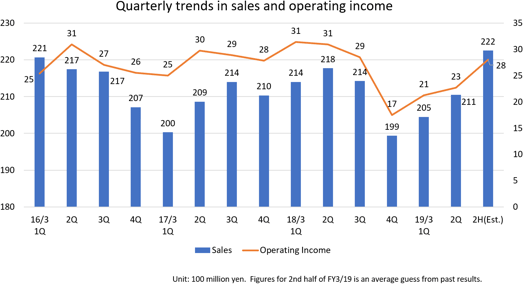 Quarterly performance is recovering after bottoming out in the 4th quarter of the term ended Mar. 2018. The forecast for the second half of the current term has been revised downwardly, but it still exceeds that in the same period of the previous year and that in the current term.
Quarterly performance is recovering after bottoming out in the 4th quarter of the term ended Mar. 2018. The forecast for the second half of the current term has been revised downwardly, but it still exceeds that in the same period of the previous year and that in the current term.
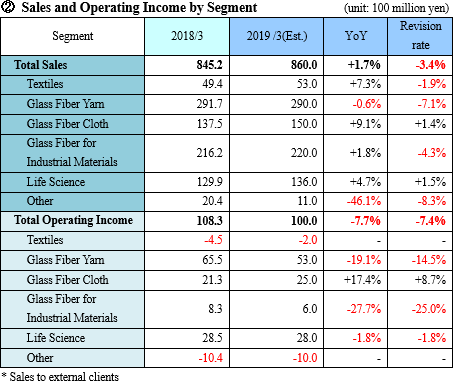 ① Textiles Business
The company aims to improve factory utilization rate through optimal production in Japan and China, and expand its share in the Chinese market. It will also enter the field of industrial materials by promoting the development of new functional materials and collaborating with the glass fiber business section.
② Glass Fiber Yarn Business and Glass Fiber Cloth Business
The demand for special glass remains healthy. The company will meet the demand for products for servers in data centers and base stations, and supply products compatible with high-speed, large-volume communications for 5G.
The company will accelerate the collaborative business with Baotek Industrial Materials Ltd. in Taiwan, whose shares were obtained by the company via TOB, and promote sales by enhancing the production capacity and output of high value-added products.
③ Glass Fiber for Industrial Materials Business
The augmentation of costs for distribution, materials, etc. will decrease profit, but the company will aim to boost its earning capability by improving productivity.
In the sale of glass cloth for industrial uses, the company will concentrate on opening overseas markets and increasing new clients.
④ Life Science Business
* Medical
While strengthening R&D and selling systems, the company aims to boost productivity for increasing production output.
It will further fortify the system for all processes from procuring materials to finishing products, to enhance the capabilities of development and supply.
It will keep accelerating global business expansion.
* Specialty chemicals
The company will reinforce its marketing system, to sell more products inside and outside Japan.
* Beverages
The company will proceed with the development and fortification of its production system, and secure a stable revenue base.
It will develop and suggest new products.
① Textiles Business
The company aims to improve factory utilization rate through optimal production in Japan and China, and expand its share in the Chinese market. It will also enter the field of industrial materials by promoting the development of new functional materials and collaborating with the glass fiber business section.
② Glass Fiber Yarn Business and Glass Fiber Cloth Business
The demand for special glass remains healthy. The company will meet the demand for products for servers in data centers and base stations, and supply products compatible with high-speed, large-volume communications for 5G.
The company will accelerate the collaborative business with Baotek Industrial Materials Ltd. in Taiwan, whose shares were obtained by the company via TOB, and promote sales by enhancing the production capacity and output of high value-added products.
③ Glass Fiber for Industrial Materials Business
The augmentation of costs for distribution, materials, etc. will decrease profit, but the company will aim to boost its earning capability by improving productivity.
In the sale of glass cloth for industrial uses, the company will concentrate on opening overseas markets and increasing new clients.
④ Life Science Business
* Medical
While strengthening R&D and selling systems, the company aims to boost productivity for increasing production output.
It will further fortify the system for all processes from procuring materials to finishing products, to enhance the capabilities of development and supply.
It will keep accelerating global business expansion.
* Specialty chemicals
The company will reinforce its marketing system, to sell more products inside and outside Japan.
* Beverages
The company will proceed with the development and fortification of its production system, and secure a stable revenue base.
It will develop and suggest new products.
|
| Progress of the <<Go for Next 100>> Mid-term Business Plan |
|
(1) "Long-term Vision 101" and the mid-term business plan "Go for Next 100"
The company decided on "Long-term Vision 101" for surviving and growing sustainably while seeing overseas markets, as Japan is faced with the declining birthrate, the super aging population, and the decline in total demand, and defined the ideal corporate vision in fiscal 2023, which is the 101st anniversary of establishment of the company, as follows: "Nittobo delivers the unique products and innovations globally from Fukushima in Japan based on customer relations and technology."
As the first stage for achieving "Long-term Vision 101," the company formulated the mid-term business plan "Go for Next 100," whose final year is fiscal 2020, and this plan is ongoing.
The company will first establish the foundation for keeping profitability at the current level, seize a chance to grow, identify the advantages of the corporate group, and pursue it thoroughly.
(2) Activities in each business
"Long-term Vision 101" defines the ideal corporate vision of each business in fiscal 2023 as follows.
 ① Glass Fiber Business
The objectives are "Reinforce the electronic materials area further" and "Strengthen the industrial materials area."
As for the former objective, as semiconductors are becoming more ultra-fine and high-performance because high-speed, large-volume communications, including 5G, are realized, and the demand for high value-added glass cloth is expected to grow, the company will produce finer and thinner "E Glass," find more purposes of use of special glass, such as the high value-added products "T Glass" and "NE Glass," enhance its production capacity, and complement production capacity through M&A.
As for the latter objective, the company plans to introduce special glass to the field of industrial materials, actively enter overseas markets, and establish the customer solution section.
With the establishment of the customer solution section, the company will promote new purposes of use of "T Glass," which is now used in electronic substrates for semiconductor packages, and "NE Glass," which is now used in electronic substrates for servers in data centers and base stations.
The company will enhance the business for industrial materials, to meet the needs for composite materials made from high-strength glass for aircraft and automobiles with "T Glass" and the needs for low dielectric and low transmission loss with "NE Glass."
As for investment, the company will make investments mainly for making "E Glass" ultra-fine, boosting the production capacity for the high value-added products "T Glass and NE Glass," and increasing their purposes of use.
Major activities of each business for the glass fiber business are as follows. ① Glass Fiber Business
The objectives are "Reinforce the electronic materials area further" and "Strengthen the industrial materials area."
As for the former objective, as semiconductors are becoming more ultra-fine and high-performance because high-speed, large-volume communications, including 5G, are realized, and the demand for high value-added glass cloth is expected to grow, the company will produce finer and thinner "E Glass," find more purposes of use of special glass, such as the high value-added products "T Glass" and "NE Glass," enhance its production capacity, and complement production capacity through M&A.
As for the latter objective, the company plans to introduce special glass to the field of industrial materials, actively enter overseas markets, and establish the customer solution section.
With the establishment of the customer solution section, the company will promote new purposes of use of "T Glass," which is now used in electronic substrates for semiconductor packages, and "NE Glass," which is now used in electronic substrates for servers in data centers and base stations.
The company will enhance the business for industrial materials, to meet the needs for composite materials made from high-strength glass for aircraft and automobiles with "T Glass" and the needs for low dielectric and low transmission loss with "NE Glass."
As for investment, the company will make investments mainly for making "E Glass" ultra-fine, boosting the production capacity for the high value-added products "T Glass and NE Glass," and increasing their purposes of use.
Major activities of each business for the glass fiber business are as follows.
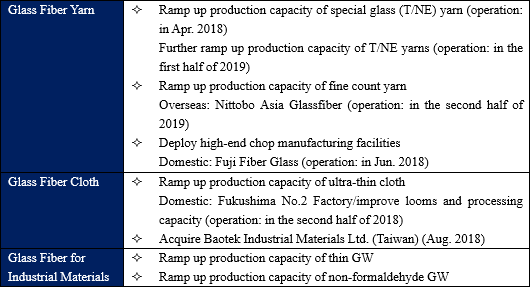 The company will reorganize Baotek, which manufactures and sells glass cloth in Taiwan, into an equity method affiliate by spending about 4 billion yen, and transform it into a subsidiary.
The purposes in transforming it into a subsidiary are to enhance the capacity for producing glass cloth, develop a system for integrally supplying high value-added products ranging from yarns to cloth in Taiwan, which is the hub of electronic material production, utilize broad supply chains, including the industrial material domain of Baotek, and so on.
The company also considered that the subsidiary would produce some merits for supplying products stably through geographical supplement and implementing a BCP.
② Life Science Business
For the in-vitro diagnostics business, the company takes full advantage of the integrated manufacturing systems in Japan and the U.S. and supplies high value-added agents that meet the needs for diversification and elaboration for contributing to self-medication.
In Japan, there is a growing trend in which patients conduct self-medication or diagnose themselves with a compact portable analyzer called Point of Care Testing (POCT), and determine a treatment policy by themselves for curbing medical expenses.
Outside Japan, the demand for high value-added medicine (such as highly sensitive immunological reagents, examinations for infections and genes) is growing in advanced countries.
In these circumstances, the company will implement the following measures for the in-vitro diagnostics business.
The company will reorganize Baotek, which manufactures and sells glass cloth in Taiwan, into an equity method affiliate by spending about 4 billion yen, and transform it into a subsidiary.
The purposes in transforming it into a subsidiary are to enhance the capacity for producing glass cloth, develop a system for integrally supplying high value-added products ranging from yarns to cloth in Taiwan, which is the hub of electronic material production, utilize broad supply chains, including the industrial material domain of Baotek, and so on.
The company also considered that the subsidiary would produce some merits for supplying products stably through geographical supplement and implementing a BCP.
② Life Science Business
For the in-vitro diagnostics business, the company takes full advantage of the integrated manufacturing systems in Japan and the U.S. and supplies high value-added agents that meet the needs for diversification and elaboration for contributing to self-medication.
In Japan, there is a growing trend in which patients conduct self-medication or diagnose themselves with a compact portable analyzer called Point of Care Testing (POCT), and determine a treatment policy by themselves for curbing medical expenses.
Outside Japan, the demand for high value-added medicine (such as highly sensitive immunological reagents, examinations for infections and genes) is growing in advanced countries.
In these circumstances, the company will implement the following measures for the in-vitro diagnostics business.
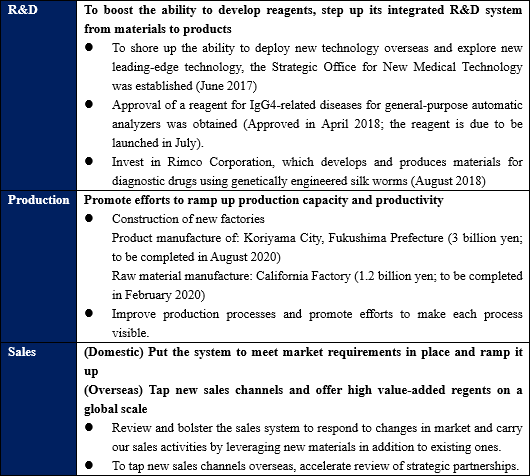 The candidates for new technologies and products are companion diagnostics, which are used for medical examinations before actual administration of medicines in order to predict the effects of medicines, the risks of side effects, and appropriate dosages for respective patients, and diagnostic drugs for cancer screening, which are expected to be in higher demand.
A total of three companies, including Nitto Boseki, obtained the approval for reagents for IgG4-related diseases.
As for sales, the company will concentrate on the increase of global clients, considering the fact that about 70% of in-vitro diagnostics are sold in Japan.
③ Textiles Business
The company will polish its own technologies and develop and promote higher value-added products from the viewpoints of light weight, moisture permeability, water absorbing and fast drying, deodorant property, prevention of static electrification, and eco-friendliness.
The company will try to break out of fashion and apparel, and expand the purposes of use of materials for sports, medicine, daily necessities, industrial materials, etc. while putting importance on functions.
④ R&D System
In order to brush up the company-side R&D capacity, the company decided to construct a new building in Koriyama-shi, Fukushima Prefecture. Total construction cost is 2.7 billion yen, and it is scheduled to be completed in Apr. 2020.
In addition, as a new R&D foothold, the company opened the satellite laboratory "NI-Tech" in Kawasaki City Innovation Center of Nano Medicine in Jul. 2018.
(3) Numerical goals
The numerical goals in "Go for Next 100" for fiscal 2020 and in "Long-term Vision 101" for fiscal 2023 are as follows.
The candidates for new technologies and products are companion diagnostics, which are used for medical examinations before actual administration of medicines in order to predict the effects of medicines, the risks of side effects, and appropriate dosages for respective patients, and diagnostic drugs for cancer screening, which are expected to be in higher demand.
A total of three companies, including Nitto Boseki, obtained the approval for reagents for IgG4-related diseases.
As for sales, the company will concentrate on the increase of global clients, considering the fact that about 70% of in-vitro diagnostics are sold in Japan.
③ Textiles Business
The company will polish its own technologies and develop and promote higher value-added products from the viewpoints of light weight, moisture permeability, water absorbing and fast drying, deodorant property, prevention of static electrification, and eco-friendliness.
The company will try to break out of fashion and apparel, and expand the purposes of use of materials for sports, medicine, daily necessities, industrial materials, etc. while putting importance on functions.
④ R&D System
In order to brush up the company-side R&D capacity, the company decided to construct a new building in Koriyama-shi, Fukushima Prefecture. Total construction cost is 2.7 billion yen, and it is scheduled to be completed in Apr. 2020.
In addition, as a new R&D foothold, the company opened the satellite laboratory "NI-Tech" in Kawasaki City Innovation Center of Nano Medicine in Jul. 2018.
(3) Numerical goals
The numerical goals in "Go for Next 100" for fiscal 2020 and in "Long-term Vision 101" for fiscal 2023 are as follows.
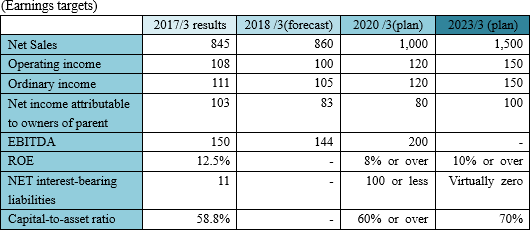    As the business portfolio for fiscal 2023, the company aims to add high value to more products, increase overseas sales ratio, and establish the medical business as the second pillar. As the business portfolio for fiscal 2023, the company aims to add high value to more products, increase overseas sales ratio, and establish the medical business as the second pillar.
 As for EBITDA, the company will invest in ultra-fine yarns and ultra-thin cloth inside Japan through the glass fiber business, make investment for making yarns thinner outside Japan, fortify an integrated manufacturing system for products ranging from yarns to cloth through M&A with Baotek in Taiwan, enhance the capacity for producing special glass inside and outside Japan, upgrade the integrated production system in the medical business in Japan and the U.S., intensify overseas business expansion, and so on for increasing its earning capacity, with the aim of earning about 16 billion yen this fiscal year, 20 billion yen in fiscal 2020, and 23 to 25 billion yen in fiscal 2023. As for EBITDA, the company will invest in ultra-fine yarns and ultra-thin cloth inside Japan through the glass fiber business, make investment for making yarns thinner outside Japan, fortify an integrated manufacturing system for products ranging from yarns to cloth through M&A with Baotek in Taiwan, enhance the capacity for producing special glass inside and outside Japan, upgrade the integrated production system in the medical business in Japan and the U.S., intensify overseas business expansion, and so on for increasing its earning capacity, with the aim of earning about 16 billion yen this fiscal year, 20 billion yen in fiscal 2020, and 23 to 25 billion yen in fiscal 2023.
 As for equipment investment, the company plans to invest 55 billion yen in the 4-year mid-term business plan. As of Oct. 2018, which is the initial year in the plan, the company has already decided to invest about 34 billion yen, about 60% of the planned amount. As for equipment investment, the company plans to invest 55 billion yen in the 4-year mid-term business plan. As of Oct. 2018, which is the initial year in the plan, the company has already decided to invest about 34 billion yen, about 60% of the planned amount.
|
| Conclusions |
|
Although the demands for special glass remains healthy, the demand for some high value-added products has been recently weakening. So the company has revised the estimates for the second half downwardly. However, it seems that the company is still on a recovery track after bottoming out in the 4th quarter of the term ended Mar. 2018.
As the company is fortifying its business base for mid/long-term growth, we would like to see how much it will increase sales in the 3rd and 4th quarters in the short term. In the medium or long term, we would like to pay attention to the progress of measures for "Long-term Vision 101" and the mid-term business plan "Go for Next 100," especially, in addition to the the enhancement of "T Glass" and "NE Glass", the growth speed of the medical business, which is recognized as the second pillar.
|
| <Reference: Regarding Corporate Governance> |
 ◎Corporate Governance Report
Updated on Jun. 29, 2018
<Basic Policy>
Our Group aims to establish a fair and transparent management system in order to conduct business activities that put importance onto social trust from our stakeholders including shareholders and investors.
Our company introduced an executive officer system in June 2003 with the intention to make the Board of Directors more effective and expedite decision-making. As a result, a system which maximizes the effect of consolidated management has been established. Since June 2008, the business has been operated with further clarification of functions and responsibilities for business administration and business execution. Having received an approval at the ordinary general meeting of shareholders on June 26, 2014, our company has shifted to a company with committees (currently, a company with nominating committee, etc.). In the new form, our company clearly separates supervising and business execution even further and aims at "supervisory functions reinforcement and transparent business administration" and "swift execution of business and improvement of management mobility." Our company has also built functional systems, which allow us to respond more effectively to expectations of our stakeholders including our customers, shareholders, business partners, and employees and promotes further improvement of the corporate value.
<Reasons for Non-compliance with the Principles of the Corporate Governance Code (Excerpts)>
All Principles of the Corporate Governance Code before the revision in June 2018 are implemented.
The updated Principles of the Corporate Governance Code since the revision in June, 2018 will be implemented by the end of December 2018. ◎Corporate Governance Report
Updated on Jun. 29, 2018
<Basic Policy>
Our Group aims to establish a fair and transparent management system in order to conduct business activities that put importance onto social trust from our stakeholders including shareholders and investors.
Our company introduced an executive officer system in June 2003 with the intention to make the Board of Directors more effective and expedite decision-making. As a result, a system which maximizes the effect of consolidated management has been established. Since June 2008, the business has been operated with further clarification of functions and responsibilities for business administration and business execution. Having received an approval at the ordinary general meeting of shareholders on June 26, 2014, our company has shifted to a company with committees (currently, a company with nominating committee, etc.). In the new form, our company clearly separates supervising and business execution even further and aims at "supervisory functions reinforcement and transparent business administration" and "swift execution of business and improvement of management mobility." Our company has also built functional systems, which allow us to respond more effectively to expectations of our stakeholders including our customers, shareholders, business partners, and employees and promotes further improvement of the corporate value.
<Reasons for Non-compliance with the Principles of the Corporate Governance Code (Excerpts)>
All Principles of the Corporate Governance Code before the revision in June 2018 are implemented.
The updated Principles of the Corporate Governance Code since the revision in June, 2018 will be implemented by the end of December 2018.
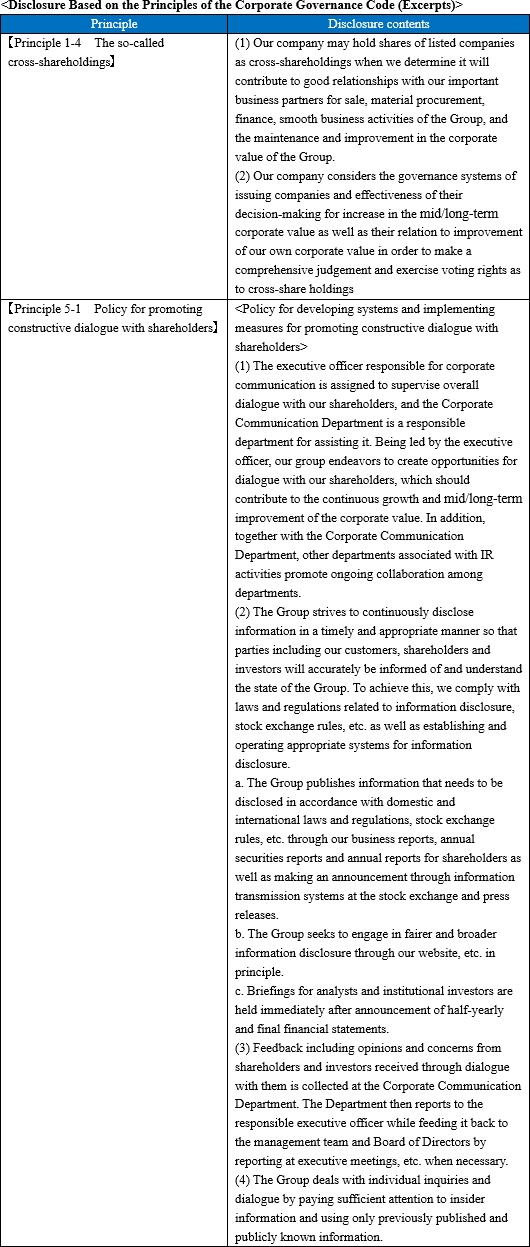 Disclaimer
This report is intended solely for informational purposes, and is not intended as a solicitation to invest in the shares of this company. The information and opinions contained within this report are based on data made publicly available by the Company, and comes from sources that we judge to be reliable. However, we cannot guarantee the accuracy or completeness of the data. This report is not a guarantee of the accuracy, completeness or validity of said information and or opinions, nor do we bear any responsibility for the same. All rights pertaining to this report belong to Investment Bridge Co., Ltd., which may change the contents thereof at any time without prior notice. All investment decisions are the responsibility of the individual and should be made only after proper consideration.Copyright(C) 2018 Investment Bridge Co.,Ltd. All Rights Reserved. |

